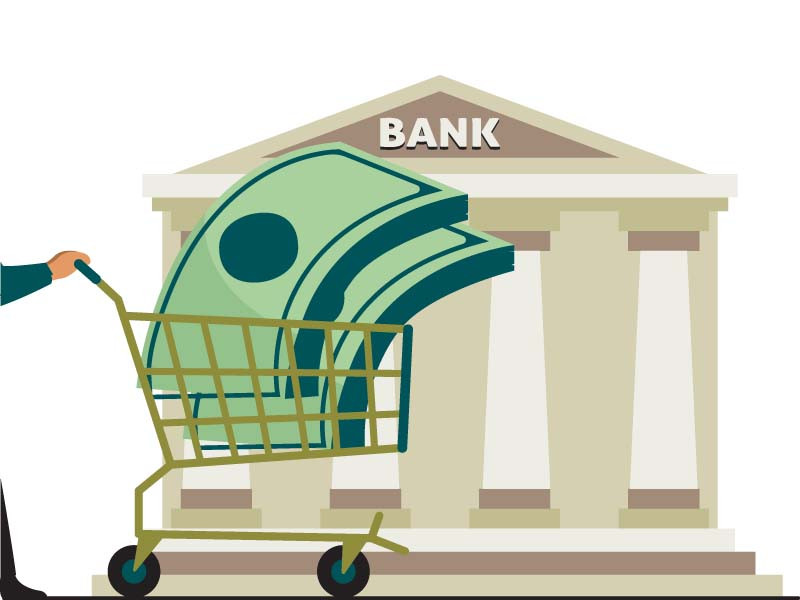
Pakistan’s latest bank credit data has depicted a worrisome picture, suggesting that financing for unproductive purposes has soared two times compared to over fivefold drop in funding for economic activities in the first nine and a half months of current fiscal year.
According to the central bank’s weekly update, commercial bank financing to governments (federal and provincial) surged to Rs3.06 trillion from July 1 to April 14, 2023 compared to Rs944.54 billion in the same period of last year.
On the other hand, credit to the private sector slowed 5.44 times to Rs219.92 billion as compared to Rs1.19 trillion last year.
Talking to The Express Tribune, KASB Securities Head of Research Yousuf Rahman said “financing is being pulled out of the economy and being provided to the government.”
He elaborated that the government’s budgetary borrowing was on the rise mainly to pay interest cost (debt servicing) of the historically high debt. “This is a non-productive expenditure.”
Interest payments are expected to grow to Rs5.5 trillion (6.5% of GDP) in the current fiscal year compared to the government’s earlier estimate of Rs3.9 trillion (4.7% of GDP), it was learnt.
The hike of a cumulative 400 basis points in the central bank’s key policy rate in March-April 2023 to 21% has inflated the interest payments. The government’s other budgetary expenditures include monthly pay and pensions, social spending and flood-related expenditures.
Besides, rising inflation, which was expected to hit a record high at 40% in April, was a leading factor behind the growth in requirement for new financing by the government, Rahman said.
A continuous surge in money supply suggests the printing of new currency notes to match the growing demand for funds coming mainly from the governments (federal and provincial).
The increased bank financing for the government proves negative for the economy as such funds should have been provided for productive activities.
Central bank data showed that bank credit to the private sector, considered an engine of economic growth, dropped over fivefold in the period under review during the current difficult times. It clearly showed that businesses had been badly hit by the ongoing economic and political crisis.
To recall, the performance of large-scale manufacturing (LSM) sector remained poor with a contraction of 5.56% in the first eight months (Jul-Feb) of FY23, according to the Ministry of Finance’s latest monthly economic update and outlook for April 2023.
Besides, the cash crop of cotton has continued to underperform partly due to the 2022 floods.
Rahman said the exorbitant hike in the policy rate made bank credit expensive and out of reach of the private sector. “This has played a leading role in the shrinking credit for the private sector.”
Moreover, bank financing to state-owned enterprises (SOEs) increased 21 times in nine and a half months of FY23 to Rs249 billion compared to Rs12 billion in the corresponding period of last year.
Although data breakdown was not available, the financial crisis suggests that the SOEs including energy firms would have borrowed money to continue to run their operations.
A leading energy firm reported to Pakistan Stock Exchange last week that a continuous surge in circular debt and high inflation forced it to borrow more from banks.
Rahman said the government’s high borrowing would push up the fiscal deficit in FY23 against the initial estimates.
The deficit will also widen due to less collection of taxes against the target. Latest reports suggest the government collected Rs400 billion less taxes in the first 10 months of FY23 compared to the target of Rs6.02 trillion.
Domestic borrowing has remained high due to the absence of external financing. Global lending institutions and some friendly countries have put on hold their funding decisions, waiting for the revival of IMF’s $7 billion loan programme.
Published in The Express Tribune, May 2nd, 2023.
Like Business on Facebook, follow @TribuneBiz on Twitter to stay informed and join in the conversation.

1718870162-0/BeFunky-collage-(60)1718870162-0-405x300.webp)
1730504285-0/Martha-(1)1730504285-0-165x106.webp)






1719053250-0/BeFunky-collage-(5)1719053250-0-270x192.webp)








COMMENTS
Comments are moderated and generally will be posted if they are on-topic and not abusive.
For more information, please see our Comments FAQ